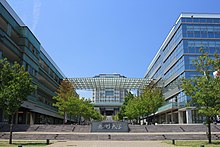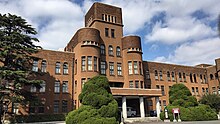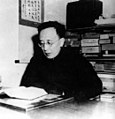Kyushu University
九州大学 | |
 | |
Former names | Kyushu Imperial University |
|---|---|
Motto in English | Opening the Door to a New Century of Knowledge |
| Type | Public (National) |
| Established | Founded 1903, Chartered 1911 |
| Affiliation | Alliance of Asian Liberal Arts Universities |
| Endowment | US$72 Million |
| Budget | $1.445 Billion |
| President | Tatsuro Ishibashi |
Academic staff | 2,110 (As of May 1, 2021)[1] |
Administrative staff | 2,351 (As of May 1, 2020)[2] |
| Students | 18,560 (As of May 1, 2022) |
| Undergraduates | 11,683[3] |
| Postgraduates | 6,877[4] |
| Location | , , Japan |
| Campus | Urban, (2.4 km2) Ito, urban, (0.4 km2) Hakozaki, urban, (0.3 km2) Maidashi, urban, (0.25 km2) Chikushi, urban, (0.063km²) Ohashi, rural, (0.1 km2) Beppu, Research Forests and Farms (72 km2) |
| Language | Japanese and English |
| Colours | Wine Red |
| Website | www |



Kyushu University (九州大学, Kyūshū Daigaku), abbreviated to Kyudai (九大, Kyūdai), is a public research university located in Fukuoka, Japan, on the island of Kyushu.
Founded in 1911 as the fourth Imperial University in Japan, it has been recognised as a leading institution of higher education and research in Kyushu, Japan, and beyond.
The history of the university began a few decades before its founding when the medical school of the Fukuoka Domain (福岡藩) was established in 1867, the final year of the Edo period. The school was reorganised as the Fukuoka Medical College of Kyoto Imperial University in 1903. It became independent as Kyushu Imperial University in 1911.
History
[edit]In 1867, the Fukuoka Domain established a medical school called Sanshikan in Tenjin, Fukuoka. Although closed in 1872, its affiliated hospital continued operating and evolved over time. By 1879, it became part of the Fukuoka Prefectural Fukuoka Medical School, later continuing as the Fukuoka Prefectural Fukuoka Hospital.[5]
The push for an imperial university in Kyushu led to the establishment of Fukuoka Medical College in 1903 as a branch of Kyoto Imperial University. Financial challenges delayed further development until the Furukawa Zaibatsu's donation in 1906 facilitated the establishment of Kyushu Imperial University in 1911, with Kenjiro Yamakawa, former president of the University of Tokyo, as its first president.[6]
Kyushu University dates its medical faculty's founding to 1903 and the university's establishment to 1911. In 1947, it was renamed Kyushu University, and in 1949, it expanded by incorporating several local educational institutions.
On July 3, 2009, Kyushu University was chosen for the “Global 30 (G30) Project”.[7]
Organisation
[edit]Kyushu University's incumbent president is Tatsuro Ishibashi, who was elected in 2020 and is expected to serve until September 2026.[8]
The university has 16 faculties, 11 undergraduate schools, and 18 graduate schools.[9][10]
- Faculty of Humanities
- Faculty of Social and Cultural Studies
- Faculty of Human-Environment Studies
- Faculty of Law
- Faculty of Economics
- Faculty of Languages and Cultures
- Faculty of Sciences
- Faculty of Mathematics
- Faculty of Medical Sciences
- Faculty of Dental Science
- Faculty of Pharmaceutical Sciences
- Faculty of Engineering
- Faculty of Engineering Sciences
- Faculty of Design
- Faculty of Information Science and Electrical Engineering
- Faculty of Agriculture
Kyushu University Hospital
[edit]Kyushu University Hospital, with historical roots in the 1867 Sanseikan established by the Kuroda Clan, evolved significantly over time. Initially a clinic for a medical institution, it became affiliated with the Fukuoka Prefectural Medical School in 1879. In 1903, it became associated with the newly formed Fukuoka Medical College, a branch of Kyoto Imperial University. The establishment of Kyushu Imperial University in 1911 brought the hospital under its Faculty of Medicine. Post-World War II reforms in 1947 led to its rebranding as the Kyushu University Faculty of Medical Sciences Affiliated Hospital, incorporating various departments, including dental science. The hospital underwent further transformations, merging in 2003 with hospitals from the Faculty of Dental Science and Medical Institute of Bioregulation to form the current Kyushu University Hospital.
The hospital's history also includes a dark chapter in 1945, involving fatal and torturous medical experiments including live dissection on American POWs by the university's medical faculty, resulting in war crimes convictions.[11][12][13]
International Education
[edit]Scholarships for international students
[edit]Kyushu offers a number of selected scholarships for international students. Some of them are:[14]
- Topia Leisure Scholarship (scholarship with work experience)
- JASSO - Encourage privately financed international students learning costs
- Fukuoka International Student Scholarship
- Ushio Foundation Scholarship
- Ajinomoto Scholarship
- Sun Noh Scholarship
Academic rankings
[edit]| THE National[15] | General | 6 | |
|---|---|---|---|
| T. Reuters National[16] | Research | 6 | |
| NBP Kyushu/Okinawa/Yamaguchi[17] | Reputation | 1 | |
| Shimano National[18] | Selectivity | SA | |
| QS Asia (Asia version)[19] | General | 34 | |
| THE Asia (Asia version)[20] | General | =52 | |
| ARWU Asia[21] | Research | 19–26 | |
| THE World[22] | General | 301–350 | |
| QS World[23] | General | 167= | |
| ARWU World[21] | Research | 301–400 | |
| ENSMP World[24] | Alumni | 38 | |
| Social Sciences & Humanities | |||
|---|---|---|---|
LAW | |||
| Natural Sciences & Technology | |||
Engineering | |||
MATERIALS SCIENCE | |||
| T.Reuters National[25] | Research | 6 | |
| T.Reuters World[25] | Research | 49 | |
CHEMISTRY | |||
| T.Reuters National[25] | Research | 6 | |
| T.Reuters World[25] | Research | 41 | |
BIOLOGY & BIOCHEMISTRY | |||
| T.Reuters National[25] | Research | 4 | |
| T.Reuters World[25] | Research | 95 | |
| Life Sciences | |||
IMMUNOLOGY | |||
| T.Reuters National[25] | Research | 4 | |
| T.Reuters World[25] | Research | 68 | |
PHARMACOLOGY & TOXICOLOGY | |||
| T.Reuters National[25] | Research | 4 | |
| T.Reuters World[25] | Research | 76 | |
| * T. Reuters World rankings include non-educational institutions | |||
General rankings
[edit]The university has been ranked 5th in the 2020 Times Higher Education Japan University Rankings,[31] which is one rank down from 2019.[32] In another ranking, Japanese prep school Kawaijuku ranked Kyushu as the 7th best university in Japan.[33]
It has been ranked 132nd in the 2020 QS World University Rankings,[34] and 401-500th in the Times Higher Education World University Rankings.[35]
According to QS, its subject rankings were 123rd in Engineering & IT, 170th in Life Sciences & Biomedicine, and 150th in Natural Sciences. It is also the 18th-best university in Asia, according to QS Asian University rankings.[36]
Popularity and selectivity
[edit]Kyushu University is a prestigious institution, and its selectivity for undergraduate degrees is regarded as being among the top 15 in the country. [37][38]
Evaluation from Business World
[edit]| Ranking | |
|---|---|
| Japan | 8th[39] (out of 781[40] universities in Japan as of 2020) |
| Source | 2020 Nikkei Survey[41] to all listed (3,714[42]) and leading unlisted (1,100), totally 4,814 companies[41] |
Notable people associated with Kyushu University
[edit]Chemistry, Physics and Engineering
[edit]-
Koichi Wakata (若田 光一) PhD, cosmonaut, the first Japanese commander of the International Space Station.
-
Toyoki Kunitake (國武 豐喜), chemist and materials scientist, 2015 Kyoto Prize winner.
-
Seiji Shinkai (新海 征治), pioneer in molecular self-assembly, but missed out on the 2016 Nobel Prize in Chemistry.
-
Kōsuke Morita (森田 浩介), experimental nuclear physicist, known as the leader of the Japanese team that discovered element 113.
- Kyozi Kawasaki (川崎 恭治), physicist, 2001 Boltzmann Medal winner.
- Genichi Taguchi (田口 玄一), engineer and statistician.
- Heitaro Nakajima, (中島 平太郎), digital audio pioneer, president Aiwa
Physiology or Medicine
[edit]-
Ryukichi Inada (稲田 龍吉), physician, 1919 Nobel Prize in Physiology or Medicine nominee.
-
Fujiro Katsurada (桂田 富士郎), a parasitologist who discovered a parasite called Schistosoma japonicum.
-
Sunao Tawara (田原 淳), a pathologist who discovered the atrioventricular node (Node of Tawara)
-
Tetsu Nakamura (中村 哲), physician, headed Peace Japan Medical Services (PMS), 2003 Ramon Magsaysay Award winner.
- Inokichi Kubo (久保 猪之吉), pioneer of otorhinolaryngology.
- Ōmori Harutoyo (大森 治豊), surgeon and first president of the Fukuoka Medical College.
- Yutaka Ido (井戸 泰), surgeon, 1919 Nobel Prize in Physiology or Medicine nominee.
- Naosuke Onodera (小野寺 直助), surgeon, 1937 Nobel Prize in Physiology or Medicine nominee.
- Kazuo Yamafuji (山藤 一雄), scientist, 1964 Nobel Prize in Physiology or Medicine nominee.
- Hakaru Hashimoto (橋本 策), MD, PhD, medical scientist, discoverer of Hashimoto's thyroiditis.
- Masatoshi Nei (根井 正利), a Japanese-born American evolutionary biologist, 2013 Kyoto Prize winner.
- Yoshizumi Ishino (石野 良純), molecular biologist, known for his discovering the DNA sequence of CRISPR.
- Takehiko Sasazuki (笹月 健彦) MD, PhD emeritus professor, professor of Kyushu University Institute for Advanced Study (高等研究院)[43]
Literature and History
[edit]-
Guo Moruo (郭沫若), a Chinese archaeologist, historian, poet, politician, and writer.
-
Yasushi Inoue (井上 靖), drop out, a Japanese writer, 1950 Akutagawa Prize winner and Nobel Prize in Literature nominee.[44]
-
Junzo Shono(庄野 潤三), a Japanese novelist, Akutagawa award winner
- Junzo Shono (庄野 潤三), a Japanese novelist, 1954 Akutagawa Prize winner.
- Toshio Shimao (島尾 敏雄), a Japanese novelist, 1977 Yomiuri Prize winner.
- Kyoichi Katayama (片山 恭一), a Japanese author.
- Rizō Takeuchi (竹內 理三), historian
- Wolfgang Michel-Zaitsu, historian, first foreigner granted a tenure at a Japanese national university in 1984.
- Hsu Hsing-Ching (徐興慶), president of Chinese Culture University in Taiwan.
- Yasuhisa Hara (原 泰久), a Japanese cartoonist.
- Kyojin Onishi (大西巨人), a Japanese novelist, Marxist
- Kyoko Funahashi (舟橋 京子), Japanese bioarchaeologist
Politics and Business
[edit]-
Shozaburo Jimi (自見 庄三郎) MD, PhD, Minister of Posts and Telecommunications
-
Hsu Shih-hsien (許世賢), a Taiwanese academic and politician, the first Taiwanese woman to earn a doctorate.
-
Tomihisa Taue (田上 富久), mayor of Nagasaki.
- Shinya Izumi(泉 信也) Politician
- Robert T. Huang, SYNNEX Corporation founder
See also
[edit]- National Seven Universities
- Campus of Kyushu University
- Kyushu Institute of Design
- Kyoto University
- Maidashi kyudai byoin mae
- IBM/Google Cloud Computing University Initiative
- Experimentation on American POWs
References
[edit]- ^ At a Glance Fast Facts 2021-2022 (PDF). Kyushu University. p. 3.
- ^ "教職員数" (PDF). Kyushu University.(in Japanese) Including 1,182 hospital staff
- ^ "学生現員数(学部生)" (PDF). Kyushu University. May 1, 2022.(in Japanese)
- ^ "学生現員数(大学院生)" (PDF). Kyushu University. May 1, 2022.(in Japanese)
- ^ "History | University Overview | About | KYUSHU UNIVERSITY". 九州大学(KYUSHU UNIVERSITY). Retrieved 2024-02-08.
- ^ "KYUSHU UNIVERSITY". 九州大学(KYUSHU UNIVERSITY). Retrieved 2024-02-08.
- ^ "Archived copy" (PDF). Archived from the original (PDF) on 2016-03-05. Retrieved 2016-02-22.
{{cite web}}: CS1 maint: archived copy as title (link) - ^ "Board of Trustees / Management Council / Education and Research Council organization | Organization | University Overview | About | KYUSHU UNIVERSITY". 九州大学(KYUSHU UNIVERSITY). Retrieved 2024-02-08.
- ^ "Kyushu University". Times Higher Education (THE). 2021-10-27. Retrieved 2024-02-08.
- ^ "Organization Chart | Organization | University Overview | About | KYUSHU UNIVERSITY". 九州大学(KYUSHU UNIVERSITY). Retrieved 2024-02-08.
- ^ "Japan revisits its darkest moments where American POWs became human experiments". TheGuardian.com. 13 August 2015.
- ^ "WWII prisoners of war used for live experiments in Japan had parts of their brains cut out". Independent.co.uk. 7 April 2015.
- ^ "New Kyushu museum breaks taboo with POW vivisection display". 4 April 2015.
- ^ "Maritime, Offshore and Logistics Degree & Training Programs - EduMaritime". www.edumaritime.net. Retrieved 2024-02-08.
- ^ "Japan University Rankings 2023". Times Higher Education. 2023. Retrieved March 23, 2023.
- ^ "Thomson Reuters 20 Top research institutions in Japan". Thomson Reuters. 2011. Retrieved July 22, 2022. (this ranking includes 5 non-educational institutions)
- ^ "Nikkei BP Brand rankings of Japanese universities" (in Japanese). Nikkei Business Publications. 2010. Retrieved April 29, 2011.
- ^ "GBUDU University Rankings" (in Japanese). YELL books. 2009. Retrieved April 29, 2011.
- ^ "QS World University Rankings: Asia 2025". QS Quacquarelli Symonds Limited. 2025. Retrieved November 6, 2024.
- ^ "Times Higher Education Asia University Rankings". Times Higher Education. 2024. Retrieved April 30, 2024.
- ^ Jump up to: a b "Academic Ranking of World Universities". Institute of Higher Education, Shanghai Jiao Tong University. 2024. Retrieved August 15, 2024.
- ^ "THE World University Rankings". Times Higher Education. 2025. Retrieved October 9, 2024.
- ^ "QS World University Rankings". QS Quacquarelli Symonds Limited. 2025. Retrieved June 4, 2024.
- ^ "ENSMP World University Rankings" (PDF). École nationale supérieure des mines de Paris. 2011. Retrieved April 29, 2011.
- ^ Jump up to: a b c d e f g h i j k l "Thomson Reuters 10 Top research institutions by subject in Japan" (in Japanese). Thomson Reuters. 2010. Retrieved May 11, 2011.
- ^ Asahi Shimbun University rankings 2010 "Publification rankings in Law (Page 4)" (PDF) (in Japanese). Asahi Shimbun. 2010. Retrieved May 11, 2011.
- ^ "Kawaijuku japanese universities rankings in Engineering field" (in Japanese). Kawaijuku. 2012. Retrieved July 20, 2012.
- ^ "QS topuniversities world rankings in Engineering field". Topuniversities. 2012. Retrieved July 20, 2012.
- ^ Jump up to: a b "ARWU in Mathematics". Shanghai Jiaotong University. 2011. Retrieved May 11, 2011.
- ^ Jump up to: a b "ARWU in Computer Science". Shanghai Jiaotong University. 2010. Retrieved May 11, 2011.
- ^ "Japan University Rankings 2020". Times Higher Education (THE). 2020-05-30. Retrieved 2020-05-30.
- ^ "Japan University Rankings 2019". Times Higher Education (THE). 2020-05-30. Retrieved 2020-05-30.
- ^ "Kawai 30 Top Japanese Universities". Kawaijuku. 2001. Retrieved April 29, 2011.
- ^ "QS World University Rankings 2020: Top Global Universities | Top Universities". Top Universities. 2020-03-18. Retrieved 2020-03-18.
- ^ "World University Rankings". Times Higher Education (THE). 2017-08-18. Retrieved 2019-05-14.
- ^ "QS University Rankings: Asia - 2011". Top Universities. 2012-12-19. Retrieved 2013-11-08.
- ^ e.g. Yoyogi seminar published Hensachi (the indication showing the entrance difficulties by prep schools) rankings "Archived copy". Archived from the original on 2011-04-22. Retrieved 2016-07-29.
{{cite web}}: CS1 maint: archived copy as title (link) - ^ Japanese journalist Kiyoshi Shimano ranks Kyushu's entrance difficulty as SA (most selective/out of 11 scales) in Japan. 危ない大学・消える大学 2012年版 (in Japanese). YELL books. 2011. ASIN 4753930181.
- ^ Survey on the image seen from human resources personnel:Ranking of the ability to get jobs|Nikkei HR 2020.06.03 release
- ^ "The number of universities in Japan is 781 as of April 1, 2020. About 80% are private universities.|Ōbun Sha" (PDF). Archived from the original (PDF) on January 30, 2021. Retrieved February 11, 2021.
- ^ Jump up to: a b Image held by human resources personnel of companies of Japan / Yokohama National University ranked 1st in Kantō & Kōshin'etsu region / Valuation from the ex-students already employed / The Nikkei・Nikkei HR Survey 2020-06-04 17:27
- ^ Number of listed companies & listed shares of stock|JPX
- ^ 九州大学高等研究院・組織・メンバー Archived 2014-11-29 at the Wayback Machine (in Japanese)
- ^ 安部公房は受賞寸前だった…ノーベル委員長語る YOMIURI ONLINE2012年3月23日












![Yasushi Inoue (井上 靖), drop out, a Japanese writer, 1950 Akutagawa Prize winner and Nobel Prize in Literature nominee.[44]](http://upload.wikimedia.org/wikipedia/commons/thumb/a/ad/Inoue_Yasushi.JPG/94px-Inoue_Yasushi.JPG)




